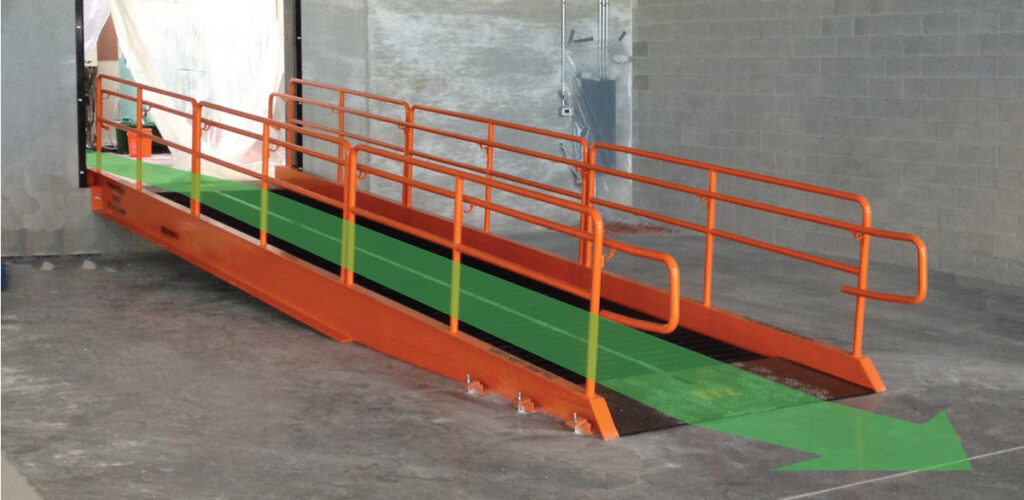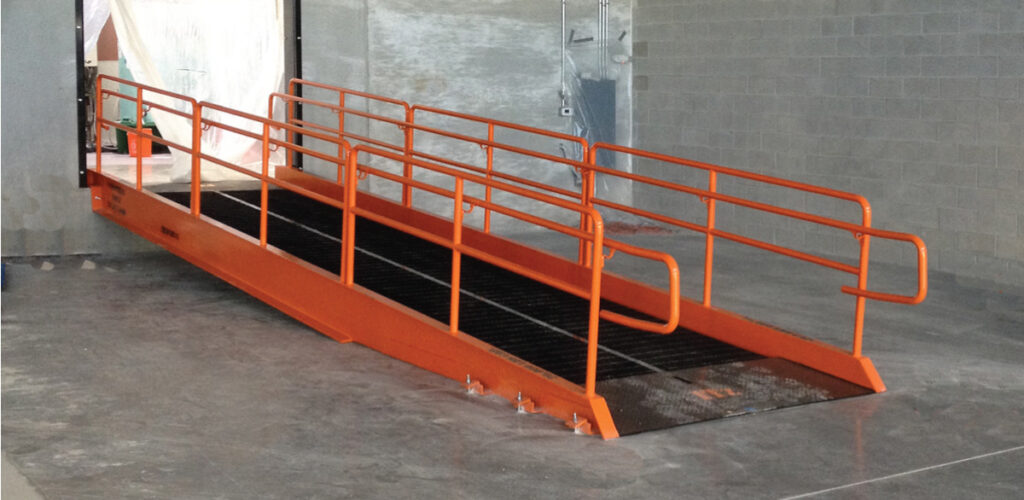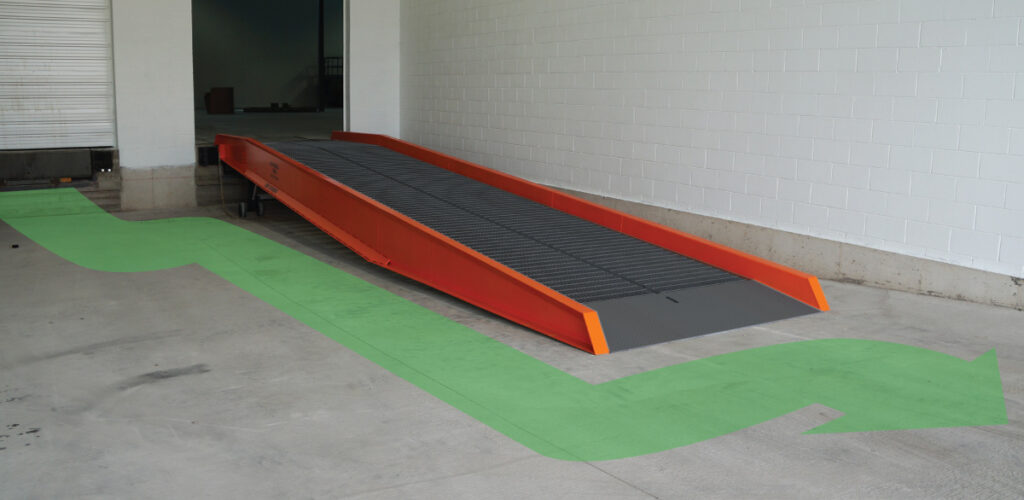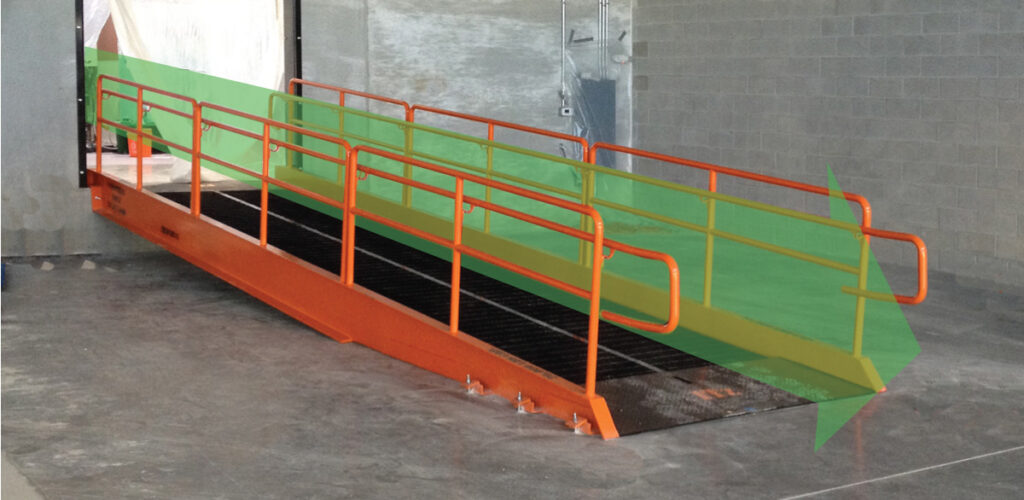Walking-Working Surfaces
(29 CFR 1910 Subpart D)General Requirements (1910.22)
This section of the walking-working surfaces regulations addresses the general requirements for ensuring safe walking and work surfaces. While employees generally do not walk on yard ramps, they are still considered a work surface as employees will be using forklifts or other vehicles on the ramp to load and unload pallets and equipment. The following regulations from 1910.22 have direct or indirect involvement with the use of yard ramps:- (a)(3) Walking-working surfaces are maintained free of hazards such as sharp or protruding objects, loose boards, corrosion, leaks, spills, snow, and ice.
- (b) Loads. The employer must ensure that each walking-working surface can support the maximum intended load for that surface.
- (d)(1) Walking-working surfaces are inspected, regularly and as necessary, and maintained in a safe condition

(a)(3) Because employees will be working on the yard ramp, it is crucial to ensure that it is free of debris. When moving payloads and cargo, if any pieces escape the pallets, make sure it is removed before work continues. This regulation is also especially pertinent if your yard ramp is stored and used outdoors. Freezing temperatures and heavy snowfall can cause snow and ice to accumulate on the ramp. This must be removed to ensure safe usage. A great way to further avoid this is to store your yard ramp under a tarp or follow these tips for using a yard ramp in the winter</
(b) Industrial Toolz yard ramps have a weight capacity of either 20,000 or 30,000 lbs. In order for the yard ramp to support the intended load, ensure that the weight of the forklift and cargo being transported on the ramp do not excede the weight capacity of the portable loading dock. In short, the minimum weight capacity of your yard ramp should be three times the weight of the maximum loading capacity of the forklift (forklift capacity x 3 = the minimum capacity the ramp should have).
(d)(1)Work surfaces should also be inspected regularly, much like your yard ramp should be inspected regularly. Your yard ramp should also have a consistent maintenance schedule to ensure it’s in safe, working order at all times.
To adhere to these OSHA walking-working surfaces regulations:
- Ensure the yard ramp and surrounding work area are clear of debris and hazards.
- Perform regular inspections and maintenance on your yard ramp.
- Ensure that the weight of whatever you are transporting does not exceed the weight capacity of your yard ramp.

Fall Protection
(29 CFR 1926 Subpart M)Duty to Have Fall Protection (1926.501)
For settings where yard ramps are commonly used, like construction, the Fall Protection standard becomes relevant. Subpart M outlines requirements for fall protection systems, training, and other safety measures to prevent falls. When incorporating yard ramps in construction projects, employers must assess fall hazards and implement appropriate safeguards.- (a)(2) The employer shall determine if the walking/working surfaces on which its employees are to work have the strength and structural integrity to support employees safely. Employees shall be allowed to work on those surfaces only when the surfaces have the requisite strength and structural integrity.<
- (a)(6) Ramps, runways, and other walkways. Each employee on ramps, runways, and other walkways shall be protected from falling 6 feet (1.8 m) or more to lower levels by guardrail systems.
- It is made of high-strength, durable steel. As long as the weight capacity is not exceeded, your yard ramp will not fail you.
- The top height of your yard ramp does not exceed 6 feet. Still, Industrial Toolz yard ramps have safety side curbs to ensure forklifts and other vehicles do not drive off the sides of the ramp. We can also add optional handrails to the sides of your portable loading dock if it’s frequently used for walking access from the ground to trailer or war<

Materials Handling and Storage
(29 CFR 1910 Subpart N) While not explicitly addressing yard ramps, the Material Handling Equipment standard emphasizes safe practices when handling materials. This includes proper storage, handling, and movement of materials, which may involve the use of yard ramps. Employers should implement measures to prevent accidents related to material handling, considering the unique aspects of yard ramp use.Handling Materials—General (29 CFR 1910.176)
- (a) Use of mechanical equipment. Where mechanical handling equipment is used, sufficient safe clearances shall be allowed for aisles, at loading docks, through doorways and wherever turns or passage must be made. Aisles and passageways shall be kept clear and in good repair, with no obstruction across or in aisles that could create a hazard. Permanent aisles and passageways shall be appropriately marked.
Powered Industrial Trucks (29 CFR 1910.178)
- General Requirements (a)(1) This section contains safety requirements relating to fire protection, design, maintenance, and use of fork trucks, tractors, platform lift trucks, motorized hand trucks, and other specialized industrial trucks powered by electric motors or internal combustion engines. This section does not apply to compressed air or nonflammable compressed gas-operated industrial trucks, nor to farm vehicles, nor to vehicles intended primarily for earth moving or over-the-road hauling.
- There should be ample space around the yard ramp to allow for the safe usage of forklifts and other vehicles working on the yard ramp.
- Any employees operating forklifts or other vehicles on the yard ramp should be properly trained to do so.
OSHA and Industrial Toolz Approved
While OSHA doesn’t have specific regulations exclusively dedicated to yard ramps, businesses must adhere to existing standards to ensure the safety of their workers. Regular maintenance, proper training, and hazard assessments are crucial components of a comprehensive safety program. By doing so, businesses can not only achieve compliance with OSHA standards but also foster a culture of safety and reduce the risk of workplace incidents associated with yard ramp use.
Additionally, Industrial Toolz makes it easy to adhere to these guidelines due to the rigorous standards we have in place for manufacturing our ramps. As the oldest custom ramp manufacturer in the world, Industrial Toolz’ team of expert engineers has designed and fabricated a high-strength and durable portable loading dock that safely facilitates the loading and unloading of trucks and trailers. Just give our friendly ramp experts a call today at 262-671-5000!
